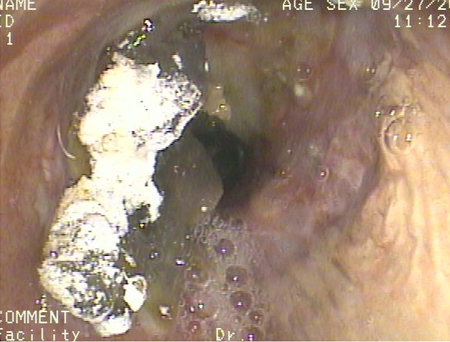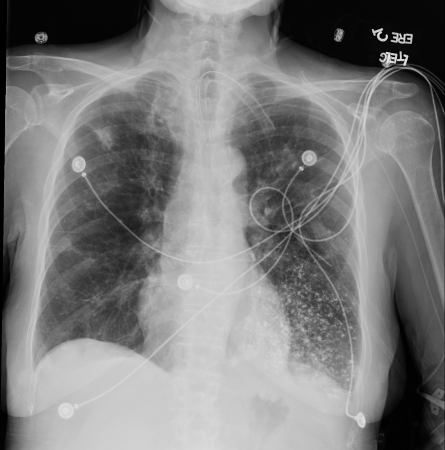Epidemiology
Pulmonary aspiration of gastric contents can occur in the perioperative period, with various risk factors including reduced consciousness, prolonged supine positioning, and illness acuity predisposing an individual to aspiration of gastric contents. Studies published in 1986 and 1993 reported that aspiration occured in 1 in every 3000 cases of anaesthesia and accounted for 10% to 30% of deaths associated with anaesthesia.[3][4] Although the incidence of aspiration has remained low and relatively constant, the extent of surgery has increased in the sick and older population, who are expected to have a higher incidence of aspiration.[5]
Dysphagia may cause ‘acute on chronic’ aspirations. According to one systematic review from 2005, the incidence of dysphagia (swallowing difficulties) following acute stroke was reported to vary from 37% to 78% depending on the site of the stroke and screening tools used to identify dysphagia.[6][7]
A review from 2010 reported that 30% of older patients with dysphagia present with aspiration.[8]
Among patients admitted to hospital who are receiving enteral nutrition, the reported prevalence varies widely from 4.4% to nearly 90%, depending on how aspiration is defined (silent versus symptomatic), the method of diagnosis, the position of the feeding tube in the gastrointestinal tract (nasogastric or nasojejunal), and the type of feeding tube (nasogastric or gastrostomy).[9][10] Clinically evident aspiration, however, is rare and is seen in <1% of patients given enteral nutrition.[10]
In the setting of severe trauma, the incidence of gross aspiration can be as high as 38%.[11]
Accidental aspiration of barium contrast medium during radiological investigations is rare.[12] The severity of the pulmonary damage depends on the density of the suspension, with high-density barium sulfate causing the most damage and being potentially fatal, especially in older patients.[13][14][15][Figure caption and citation for the preceding image starts]: Bronchoscopy showing barium aspiration in a lung transplant patient in the right mainstem bronchus after a barium swallow studyFrom the collection of Dr Kamran Mahmood [Citation ends].
Risk factors
Abnormal swallowing increases risk for aspiration.[29] Patients with dysphagia have delayed triggering of the pharyngeal motor response and decreased laryngeal elevation, resulting in poor co-ordination and timing of oral, pharyngeal, and laryngeal events during swallowing.[30]
High-risk conditions resulting in oropharyngeal dysphagia include neurological disorders (cerebrovascular disease, head trauma, closed head injury, cervical spine injury, anoxia, seizure disorder, vocal cord paralysis, Parkinson's disease, amyotrophic lateral sclerosis, Alzheimer's disease), certain surgeries (for head and neck cancer, anterior and posterior cervical spine surgery, brain surgery, coronary artery bypass grafting, oesophagogastrectomy), structural abnormalities (oropharyngeal tumours, tracheo-oesophageal fistula), gastrointestinal disorders (laryngopharyngeal reflux), tracheostomy, and adverse effects from sedatives and antipsychotics.
Over one third of patients with acute stroke have aspiration documented on radiological studies.[31] Abnormal swallowing increases risk for aspiration.[29] Patients with dysphagia have delayed triggering of the pharyngeal motor response and decreased laryngeal elevation, resulting in poor co-ordination and timing of oral, pharyngeal, and laryngeal events during swallowing.[30]
Substance misuse (e.g., alcohol intoxication or opioid toxicity) is a common risk factor for acute aspiration in the UK.
Decreased level of consciousness during a general anaesthetic or in the intensive care unit results in loss of protective reflexes. Anaesthetic drugs may decrease lower and upper oesophageal sphincter tones, and promote ileus and gastroparesis, increasing risk for gastrolaryngeal reflux. Supine positioning and unsecured airways may add to the increased risk for reflux and subsequent aspiration.[5] Difficult or traumatic intubations (blood in the endotracheal tube, oesophageal intubation, and multiple intubation attempts) and laryngospasm are reported risk factors for aspiration during the perioperative period.[4][32]
Indwelling endotracheal or tracheostomy tube raises risk for aspiration. Cuffed tubes are not completely protective and mechanically interrupt glottic closure or the cardiac sphincter.[17][33][34][35] Endotracheal intubation that lasts >8 hours can result in laryngotracheal complications, which increase the risk for aspiration after extubation.[36]
Aspiration has been documented in up to 45% of critically ill trauma patients after extubation. The mechanisms are multiple and include changes in glottis anatomy caused by vocal cord ulceration and laryngeal oedema, and disruption of the swallowing reflex caused by muscle atrophy, poor co-ordination, and diminished sensory abilities of the larynx.[37]
Gastrointestinal (GI) disease (e.g., upper GI surgery, hiatal hernia), conditions that affect gastric emptying (e.g., obesity, pregnancy), and oesophageal abnormalities (e.g., dysmotility, strictures, fistulas, gastroparesis [which can be due to diabetes]) increase the risk of regurgitation and pulmonary aspiration.[38]
Risk of aspiration is higher in older patients, especially those >70 years, probably because of higher prevalence of ageing-associated degenerative neurological and cerebrovascular disorders that can cause dysphagia and/or impaired cough reflex.[17][25][29] Over 50% of patients with acute food asphyxiation are 71 to 90 years of age.[39]
Older age is also associated with frailty, and sarcopenia.[18][19]
May occur in patients with upper airway problems (such as pharyngeal pouches and vocal cord palsies) and neuromuscular disease.
Aspiration can occur during a barium radiographic examination.[Figure caption and citation for the preceding image starts]: Barium aspiration. A barium swallow was conducted in a 53-year-old woman. Imaging revealed hyperdense airway-centred material in the left lower lobe consistent with barium aspiration bronchiolitis. A tracheo-oesophageal fistula was confirmedFrom the collection of Dr Augustine Lee; used with permission of Mayo Foundation for Medical Education and Research, all rights reserved [Citation ends]. [Figure caption and citation for the preceding image starts]: Bronchoscopy showing barium aspiration in a lung transplant patient in the right mainstem bronchus after a barium swallow studyFrom the collection of Dr Kamran Mahmood [Citation ends].
[Figure caption and citation for the preceding image starts]: Bronchoscopy showing barium aspiration in a lung transplant patient in the right mainstem bronchus after a barium swallow studyFrom the collection of Dr Kamran Mahmood [Citation ends].
Risk for aspiration in males is almost twice that in females, probably because of the higher rates of neurological and cardiovascular disorders in males.
Nasoenteric feeding tubes may stimulate the pharynx and increase risk for aspiration by decreasing lower oesophageal sphincter tone.[40] Gastric placement of feeding tubes increases risk for aspiration, and postpyloric placement of the tube may have a protective effect.[10] Large feeding tubes increase risk, especially in infants and young children (not covered in this topic). It is unclear whether gastrostomy feeding tubes have lower risk for aspiration than nasogastric feeding.[41]
Patients with a history of head and neck cancers may have a tracheostomy or have had previous upper airway surgery and radiation, which further increases their risk of aspiration.
Polytrauma, particularly head and neck trauma, can result in altered mental status and impaired airway reflexes. Head trauma also increases risk for gastric content aspiration, because the elevated intracranial pressure that may result from head trauma delays gastric emptying.[41] The patient may also acutely aspirate blood in this scenario.
Independent risk factor for aspiration in critically ill patients and during perioperative period in patients undergoing general anaesthesia.[5][10] Conditions that increase the risk for gastro-oesophageal reflux include oesophageal disease (collagen vascular disease, cancer, achalasia, dysmotility), hiatus hernia, peptic ulcer disease, gastritis, bowel obstruction, ileus, and elevated intracranial pressure.[17]
Supine positioning (e.g., during feeding; dental, medical, or radiological procedures; transport; and general anaesthesia) aligns the trachea and oropharynx, and facilitates gravitational flow of gastric content in the oropharynx. Also associated with difficulty swallowing. Sedation and anaesthesia enhance risk of aspiration by obtunding the protective reflexes.[16]
Independent risk factor for aspiration related to general anaesthesia.[42]
Drugs used in anaesthesia and in the intensive care unit may reduce the lower and upper oesophageal sphincter tone and increase risk for aspiration. Drugs include atropine, glycopyrronium, dopamine, nitroprusside, ganglion blockers, thiopental, beta-adrenergic stimulants, halothane, opioids, and propofol. Tricyclic antidepressants also have this effect.[5]
Opioids can significantly delay gastric emptying and promote ileus. Glucagon-like peptide-1 (GLP-1) receptor agonists and dual glucose-dependent insulinotropic polypeptide (GIP)/GLP-1 receptor agonists are known to delay gastric emptying, and because of retained gastric contents, their use is a risk factor for aspiration during procedures requiring general anaesthesia or deep sedation.[21][22][23][24]
Use of this content is subject to our disclaimer